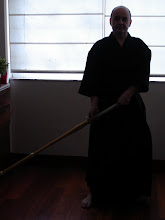It has a very well-balanced combination of kata and free practice, weapons’ work and empty-hand work and historically it is old enough to be a koryu but young enough to be influenced by the big-city culture of later-day Edo which I find fascinating.
Tennen Rishin-ryu’s relationship with Shinsengumi, the Bakumatsu-era special police force patrolling the streets of Kyoto, is so well-known even to people not involved with classic martial traditions that it can’t be ignored.
The Shinsengumi captains’ famed fighting skills notwithstanding, there’s little doubt that Tennen Rishin-ryu’s techniques were created in an era where the shinai was much more in use than the real sword.
Edo in the end of the Tokugawa bakufu was a hotbed for shiai-kenjutsu and for reinventing the training and practicing paradigm through various combinations of kata and free practice leading to the creation of hundreds of new dojo, especially in the cities and dozens of “New Ryu” created by samurai and commoners alike, all exploring and developing what would become today’s kendo.
Kato sensei’s Tennen Rishin-ryu (incidentally there are other lineages, but not having visited them I can’t speak about their interpretation) is true to that spirit and its kendo shows its roots with its throws, expanded target areas and “unorthodox” techniques like using the opponent’s do or men to choke him. Interestingly, the school’s curriculum also includes 12 iai kata, nine in seiza and three standing –quoting Mr. Furzi, “they are simple applications/basic sword drawing actions that people carrying swords were supposed to know.”
★Official website http://budojapan.com/
text and photo by Grigoris Miliaresis




No hay comentarios:
Publicar un comentario